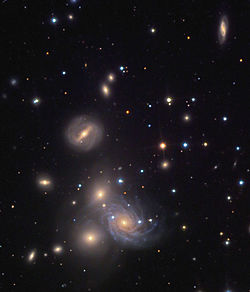| NGC 70 | |
|---|---|
 | |
| Observation data (J2000 epoch) | |
| Constellation | Andromeda |
| Right ascension | 00h 18m 22.55s |
| Declination | +30h 04m 43.4s |
| Redshift | 0.023907 [1] |
| Heliocentric radial velocity | 7167 km/s [1] |
| Distance | 320-325 Mly [2] [3] |
| Apparent magnitude (V) | 13.5 [4] [2] |
| Characteristics | |
| Type | Sb [5] Sbc [4] SA(rs)c [2] |
| Size | ~200,000 ly (60.48 kpc) (estimated) [1] |
| Apparent size (V) | ~1.7'x1.4' [5] [4] [6] |
| Other designations | |
| IC 1539, UGC 174, Arp 113, VV 166a, MCG +05-01-067, 2MASX J00182252+3004465, IRAS 00157+2948, PGC 1194, UZC J001822.6+300446 | |
NGC 70 is a spiral galaxy located in the constellation Andromeda. [7] It was discovered on October 7, 1855, by R. J. Mitchell [7] and was observed on December 19, 1897, by Guillaume Bigourdan from France who described it as "extremely faint, very small, round, between 2 faint stars". [2]
NGC 70 hosts a Seyfert Type II Active galactic nucleus (AGN).
NGC 70 is a member of a compact group of seven [8] or eight [9] galaxies, sometimes called the NGC 70 Group or the VV 166 Group.
The group comprises three relatively bright galaxies: 70, 71 and 72 in the NGC catalog, and four fainter galaxies. NGC 68 appears to be a group member, but its discrepant radial velocity and lack of tidal distortion suggest that it may be an unrelated galaxy along the group's line of sight. [9] In photographs, the NGC 70 group resembles the much more famous Stephan's Quintet group, and it is a popular target for amateur astrophotographers.
